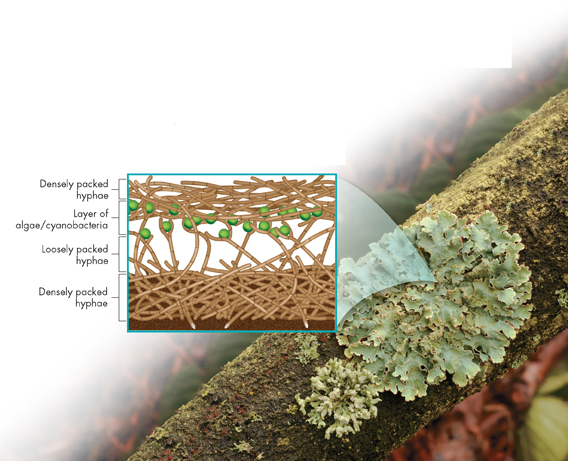Parasitic fungi can also infect humans. The fungus that causes athlete's foot forms a mycelium in the outer layers of the skin, which produces a red, inflamed sore from which the spores can easily spread from person to person. The yeast Candida albicans can also disrupt the equilibrium in the human body. It is often responsible for vaginal yeast infections and for infections of the mouth called thrush. Candida is usually kept in check by competition from bacteria and by the body's immune system. This balance can be upset by the use of antibiotics, which kill bacteria, or by damage to the immune system.
Lichens The close relationships fungi form with members of other species are not always parasitic in nature.  Some fungi form mutualistic associations with photosynthetic organisms in which both partners benefit. For example, a lichen (LY-kun) is a symbiotic association between a fungus and a photosynthetic organism. The photosynthetic organism is either a green alga or a cyanobacterium, or both. Figure 21–21 shows the structure of a lichen.
Some fungi form mutualistic associations with photosynthetic organisms in which both partners benefit. For example, a lichen (LY-kun) is a symbiotic association between a fungus and a photosynthetic organism. The photosynthetic organism is either a green alga or a cyanobacterium, or both. Figure 21–21 shows the structure of a lichen.
Lichens are extremely resistant to drought and cold. Therefore, they can grow in places where few other organisms can survive—on dry bare rock in deserts and on the tops of mountains. Lichens are able to survive in these harsh environments because of the relationship between the two partner organisms. The green algae or cyanobacteria carry out photosynthesis, providing the fungus with a source of energy. The fungus, in turn, provides the green algae or cyanobacteria with water and minerals. Furthermore, the densely packed hyphae protect the delicate green cells from intense sunlight.
Lichens are often the first organisms to enter barren environments, gradually breaking down the rocks on which they grow. In this way, lichens help in the early stages of soil formation. Lichens are also remarkably sensitive to air pollution: They are among the first organisms to be affected when air quality deteriorates.
 In Your Notebook Summarize three roles of fungi in the environment. Compare these roles to those of protists.
In Your Notebook Summarize three roles of fungi in the environment. Compare these roles to those of protists.

FIGURE 21–21 Inside a Lichen The protective upper surface of a lichen is made up of densely packed fungal hyphae. Below this are layers of green algae or cyanobacteria and loosely woven hyphae. The bottom layer contains small projections that attach the lichen to a rock or tree. Infer How do lichens assist in soil formation?
dTable of Contents
- Formulas and Equations
- Applying Formulas and Equations
- Mean, Median, and Mode
- Estimation
- Using Measurements in Calculations
- Effects of Measurement Errors
- Accuracy
- Precision
- Comparing Accuracy and Precision
- Significant Figures
- Calculating With Significant Figures
- Scientific Notation
- Calculating With Scientific Notation
- Dimensional Analysis
- Applying Dimensional Analysis




